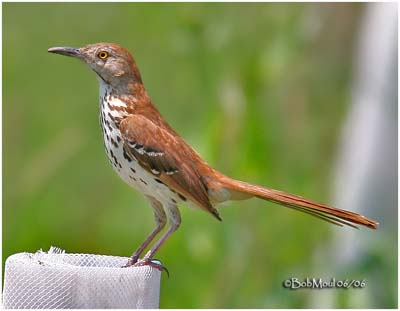
Brown Thrasher
Toxostoma rufum
Passeriforme Order – Mimidae Family
BIOMETRICS:
Length : 23-30 cm
Wingspan : 29-32 cm
Weight : 61-89 g
LONGEVITY: Up to 12 years
DESCRIPTION:
Brown Thrasher has a long rounded tail, rather short wings, and prominent, slightly decurved bill. Upperparts are reddish-brown. Underparts are white or buff, heavily streaked with black. Tail is long and reddish-brown. Brown thrasher has two whitish wing bars. Eyes are yellow. Legs and feet are pale brown yellow. Both sexes are similar.
Juvenile has grey or brown eyes, persisting until mid-winter.
Fr: Moqueur roux
All : Rotrücken-Spottdrossel
Esp : Cuitlacoche Rojizo
Ital : Mimo rossiccio
Nd : Rosse Spotlijster
Russe : Коричневый кривоклювый пересмешник
Sd : Rödbrun härmtrast
Photographs by Bob Moul
His website :
Nature Photography
Text by Nicole Bouglouan
Sources:
FIELD GUIDE TO THE BIRDS OF NORTH AMERICA by National Geographic Society - National Geographic Society - ISBN: 0792274512
WRENS, DIPPERS AND THRASHERS by Brewer David – illustrated by Barry Kent Mackay- Yale University Press - ISBN: 0300090595
A GUIDE TO THE BIRDS OF MEXICO AND NORTHERN CENTRAL AMERICA by Steve N. G. Howell, Sophie Webb - Oxford University Press - ISBN: 0198540124
All About Birds (Cornell Lab of Ornithology)
What Bird-The ultimate Bird Guide (Mitchell Waite)
Wikipedia (Wikipedia, The Free Encyclopedia)

VOICE: SOUNDS BY XENO-CANTO
Brown Thrasher’s call includes a harsh, dry “tschek”, and a whistling “pitcheree”. Song is riche and melodious, individual phrases often repeated 2/3 times. Calls include a sharp “spuck” and a low “churr”. Brown Thrasher has one of the larger song repertoires of North America birds. It may sometimes imitate the calls of other birds. A single male can sing more than 1100 song types.
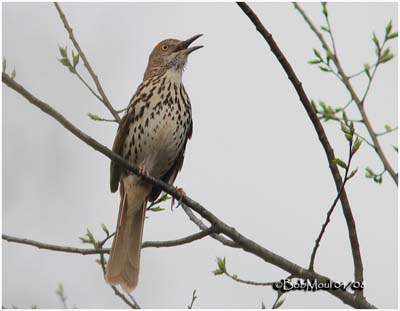
HABITAT:
In natural range, Brown Thrasher breeds in thickets, open woodlands with bushy undergrowth, shelter belts and copses, riparian areas and suburbs. It winters in hedgerows, gardens, thickets and brushy woodland edges.
RANGE:
It breeds from S Canada to E and C Texas and S Florida, westwards to SE Alberta and E Montana.
It winters from S Missouri and S New Jersey, southwards to Gulf coast, E and C Texas and S Florida.
BEHAVIOUR:
Brown Thrasher runs and especially hops on ground, with tail raised, or waving from side to side. It skulks low inside thickets, but it sings from an exposed perch.
To feed, it uses its bill to sweep leaves litter and soil away. But occasionally, it pecks and probes in litter. To search for food, it’s usually accompanied by much scratching and scattering leaves. It is a solitary bird, secretive in habits. It is quick to seek cover.
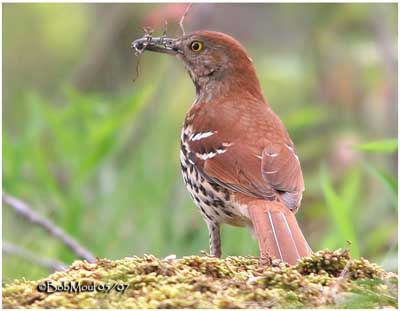
Brown Thrasher may be confused with thrushes, but is larger, with longer tail, and is streaked, not spotted below.
The male sings a series of short repeated melodious phrases from an open perch to defend its territory, and is also very aggressive in defending the nest. When two nests are placed near each other, males are seen to fight furiously, and are joined by females. Males approach each other with much caution, spreading out, and often jerking up, down, or to either side, their long fan-like tail generally betaking themselves to the ground, and uttering a note of defiance, until one of them rushes to the charge. The attack once fairly made, peace is made between the parties.
Brown Thrasher likes to bath in the water and in the sand of the roads. It bathes in small paddles during the heat of the sun, and removes to the sandy paths to roll it, for drying its plumage and freeing it of insects.
Courtship display is very curious. Male often struts before female, with tail trailing on the ground; it moves gracefully round her, and while perched and singing in her presence, it vibrates its body with vehemence.
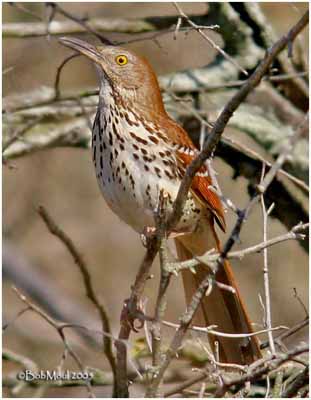
FLIGHT:
Brown Thrasher flies low, or skip from one bush to another, the longest flight seldom exceeding the breadth of a field or a river. It seems to move rather heavily, on account of the shortness of their wings, the concavity of which usually produces a rustling sound, and it travels very silently.
REPRODUCTION:
Brown Thrasher’s nest is built by both adults. Nest is placed in protected site on the ground, or low in a dense tangle of vines and foliages. Cup-shaped nest is built with twigs, and lined with grass, fibrous roots, horse hair and sometimes rags and feathers.
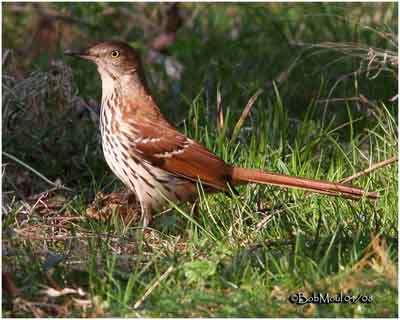
Female lays 3 to 5 pale dull buff colour sprinkled with brown eggs. Incubation lasts about 11 to 14 days, by both parents. Chicks are altricial and fledge 9 to 13 days after hatching. Both adults feed the young and brood them until they fledge, and for a short period after fledging.
These birds raise two, rarely three, broods in a year.
DIET:
Brown Thrasher feeds usually on insects and fruits. It is omnivorous, eating insects, berries, nuts and seeds, as well as earthworms, snails and sometimes lizards.
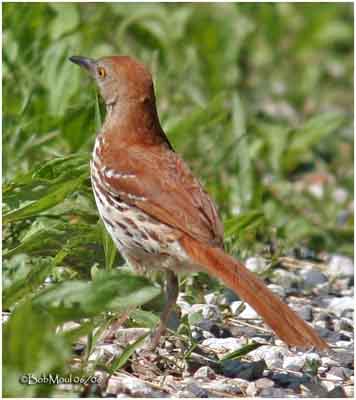
PROTECTION / THREATS / STATUS:
Populations of Brown Thrasher are in decline, with shrubby habitat loss in the eastern of North America. This species is still widespread, and its geographic range is extended in all directions during the last century. Brown Thrasher is occasionally a host for the Brown-headed Cowbird.
Brown Thrasher is the official bird of the state of Georgia.